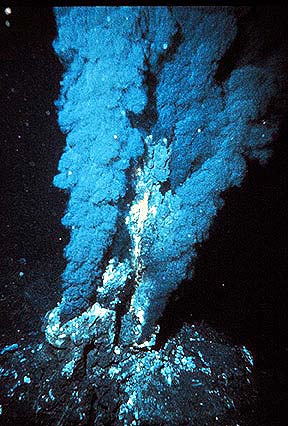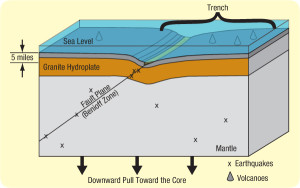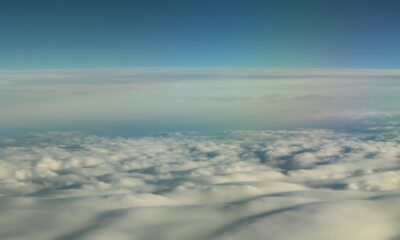Creation Corner
Subcrustal ocean roof found?

Earlier this month, a team of geologists in New Zealand reported making a seismic image of the base of the earth’s crust. They reported their find as the base of a tectonic plate. But a noted creation scientist takes heart from this find for a different reason. This team could have found the roof of a now-drained subcrustal ocean. That same ocean, he says, broke confinement about fifty-three hundred years ago. We know that break-out as the Global Flood.
A slippery layer
The journal Nature carried, in its 5 February issue, this letter from T. A. Stern and his colleagues at Victoria University of Wellington, Wellington, New Zealand. LiveScience, among other organs, carried this article describing the study. Nature also carred this commentary from Catherine Rychert. She has investigated the same problem for years, and published this study about eight years ago.
Walter T. Brown originated the Hydroplate Theory of the Global Flood about forty years ago. In a telephone interview, he described the Stern study and Dr. Rychert’s commentary in detail. The Stern team used twelve powerful dynamite charges, about 0.5 tons in all, in several bore holes in the ground. They then detonated the charges and listened for returning echoes. They heard echoes from 12 to 18 miles deep. But they also heard even deeper echoes. Those echoes come from a boundary layer 70 kilometers, or 43 miles, below ground. Deep to this lies a slippery layer, ten kilometers (six miles) thick. This layer separates the lithosphere (the top layer of the mantle) from the asthenosphere (the next layer down). This layer might be the lubricant that lets the earth’s continental plates move. As they still do.
Brown pointed out one thing the LiveScience article did not mention. Stern and his team described this in-between layer as parallel to the earth’s surface. Tia Ghose at LiveScience mentions an “extremely shallow angle” at one spot in the layer, while also calling it the “subduction zone.” In fact the angle is fifteen degrees. Most Benioff zones have a forty-five-degree incline to the ground.
A subcrustal ocean

Trench Cross Section Based on Hydroplate Theory. Notice that the trench axis will generally not be a straight line. Sediments (green) hide the top of a fault plane that would otherwise rise a few hundred feet above the floor. Other sediments (not shown) and flood basalts (dark gray) cover most of the western Pacific floor. The three large black arrows show the direction of the rising Atlantic and the forces that downwarped the mantle and the Pacific plate. Earthquakes occur on the many faults produced, especially in Benioff zones and at low tides. Most volcanoes are not above Benioff zones, but are near a myriad of other faults near the center of the western Pacific, where downwarping and shearing were greatest. Credit: Walter T. Brown, Jr.
Brown offers the Hydroplate Theory as an alternative to classic plate tectonics. According to him, earth once had a subcrustal ocean. About fifty-three hundred years ago (give or take a hundred years), it broke from its confinement. Its escape produced the Global Flood. In so doing it broke the original land mass into at least seven continental plate. Brown calls these hydroplates because they first moved on water before the subcrustal ocean finished squirting out. Remnants of that subcrustal ocean still ooze from the “Black Smokers” along the Mid-Oceanic Ridge. Brown suspects the slippery layer Stern found, formed from water still trapped in the subcrustal chamber. This explains why those plates still move.
“The problem all geologists have,” Brown said, “is: how do plates move? They try to say the mantle is viscous, or semi-liquid. The outer core of earth is liquid. But the mantle is solid. But they don’t tell children that in schools today. Nor did they tell us when we went to grade school.”
How much mass did earth lose?
[ezadsense midpost]
The escape of that subscrustal ocean also carried large amounts of water, rock and mud into space. These materials, Brown concluded early, formed the comets, the asteroids, and the meteoroids.
Last year Brown heard of the discovery of a new companion object to Sedna, a dwarf planet at the edge of the solar system. He also heard the twelve largest trans-Neptunian objects, including Sedna, had identical arguments of perihelion. Megan Schwamb, an astronomer, reported this finding. She also said any theory of the origin of these objects must account for it. Brown could see only one answer: the trans-Neptunian objects also formed from material launched from earth.
The problem: Brown had never assumed the subcrustal ocean was any deeper than ten miles below ground. Now he had to assume the subcrustal ocean was at least thirty miles deep. The subcrustal ocean, in escaping, would have to carry rock and mud from at least that deep a chasm to accumulate three percent of the earth’s mass. The three-percent guess is mid-way between two different estimates of the total mass of the Mavericks of the Solar System: two percent and four percent.
This new finding suggests the roof of the subcrustal ocean was even deeper: nearly fifty miles below ground. That would put the total mass of the “Mavericks of the Solar System” at about four percent of the earth’s mass. At least one astronomical team already believes the Mavericks amount to that much mass.
Brown still wants to validate the Stern finding. He cites another paper from a team in Costa Rica. They, he says, report a similar finding of a slippery channel about forty-five miles deep (give or take two miles or so). If those two findings prove both valid and consistent, Brown will revise his on-line work (In the Beginning: Compelling Evidence for Creation and the Flood) yet again. “At least now,” he says, “I’ll be able to remove one assumption about the subcrustal ocean. I can now observe, not assume, that it once lay about 45 miles down.”
CNAV will follow this story further as it develops.
Reprinted from examiner.com
[ezadsense leadout]
Terry A. Hurlbut has been a student of politics, philosophy, and science for more than 35 years. He is a graduate of Yale College and has served as a physician-level laboratory administrator in a 250-bed community hospital. He also is a serious student of the Bible, is conversant in its two primary original languages, and has followed the creation-science movement closely since 1993.
-

 Civilization4 days ago
Civilization4 days agoDC Pipe Bomb Arrest Raises Questions About Christopher’s Wray’s FBI
-

 Civilization5 days ago
Civilization5 days agoThe Legal Logic Behind U.S. Operations Against Narco-Terrorist Networks
-

 Executive5 days ago
Executive5 days agoNewsom’s ‘National Model’ for Homeless Wracked by Fraud
-

 Executive4 days ago
Executive4 days agoWhen You’re in a Hole, Stop Digging
-

 Executive2 days ago
Executive2 days agoWaste of the Day: Obamacare Failed Test, Approved Fraudulent Subsidies
-

 Education3 days ago
Education3 days agoWaste of the Day: Taxpayers Subsidize Football Coach Severance
-

 Civilization3 days ago
Civilization3 days agoPence Calls on Trump To Fire RFK Jr Over Abortion Drug
-

 Civilization2 days ago
Civilization2 days agoWSJ’s Fearmongering Doesn’t Survive Contact With Evidence













[…] from examiner.com and from Conservative News and […]
Alright, I’ll bite. What calculations show that “the subcrustal ocean was at least thirty miles deep. The subcrustal ocean, in escaping, would have to carry rock and mud from at least that deep a chasm to accumulate three percent of the earth’s mass”?
Care to accept Walt Brown’s debate challenge? He could tell you then.
I can see why he would want to keep his math close to his vest, given the way his orbital energy calculations came out a few months ago.
You know how I enjoy a good back-of-the-envelope calculation. Let’s see how thick a skin of material needs to be peeled off the old Earth to put 3% of its mass out into space:
Current Earth mass is 5.972e24 kg, so preFlood Earth is 6.157e24 kg. 3% of that mass is 1.847e23 kg of stuff that must be ejected. Let’s assume that this stuff is 50% water and 50% basalt by volume, with an average density of 2000 kg/m^3. You may have other estimates of the relative amounts of rock and water; feel free to repeat the calculations with your preferred numbers.
1.847e24 kg of debris at 2000 kg/m^3 is 9.23e19 m^3 of debris, or 9.23e10 km^3 in total.
The volume of a spherical shell with outer radius R and inner radius r is: (4pi/3)(R^3 – r^3). Let’s set the inner radius to the current radius of Earth: 6371 km. From above we know the shell volume is 9.23e10 km^3, so with some substitution:
R^3 = r^3 + (3/4pi)(9.23e10 km^3)
R^3 = (6371 km)^3 + 2.204e10 km^3
R^3 = 2.586e11 km^3 + 2.204e10 km^3
R^3 = 2.806e11 km^3
R = 6547 km
So the layer of material removed from the Earth (assuming density of 2g/cm^3) for a 3% loss of mass was:
(6547 km) – (6371 km) = 176 km thick, or just about 110 miles.
Or a layer of water 55 miles thick over or under a layer of rock 55 miles thick, if you prefer to think of it that way. That is quite a bit more water than exists on Earth today. By a factor of about 30. If you wanted to keep the layer of water only 1 mile thick, then to keep the ejected mass equal you have to eject about 73 miles of rock. Maybe that’s what you’re thinking here: a one mile thick layer of water buried 36 miles deep scours 36 miles of rock from above and below it as it escapes, dropping the surface by a total of about 74 miles.
Seems unwieldy. So.. if the layer mentioned in the paper at 45 miles down represents the roof of the old subcrustal ocean, where did the 55-73 miles of rock get carved out from?